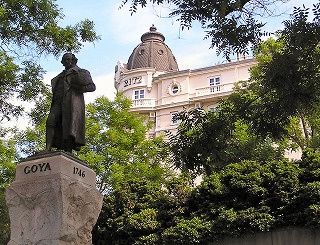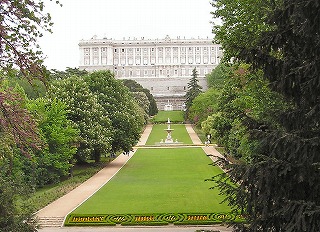|
We left Barcelona yesterday morning, dropped in at Valencia and Cuenca
on the way, and finally arrived at Madrid, the capical city, late at night.
Today is May 11. We have to begin sightseeing from early this morning too.
We started from Fiesta Gran Hotel Colon in the city center at 8:45. We
are going to visit two museums in the morning until lunch.
Madrid in a map is located in the middle of Iberian Peninsula, around the
same distance from the easternmost city Barcelona and from the westernmost
city Lisbon in Portugal.
Yesterday afternoon leaving the fortress place of Cuenca and until coming
to see the urban area of Madrid, we had views of a broad desolate plains
spread out endlessly and were comforted by the silent message far from
them. I felt touched the starting point of the guitar musics represented
by Albeniz and Rodrigo.
As soon as we entered Madrid, we saw the different world. It was a typically
modernized city which bristled with high-rise buildings with the population
of 3,090 thousand people. I did not have any interest in this city just
for this reason. However, I should not have thought of Madrid only this
way. It was not such a shallow city, but deep.
Madrid was created as a north fortress against the Islamic power in the
second half of the 9th century. But it appeared on the front stage in 1561
when Feripe 2 moved the palace here and this place became the center of
Habsburg Spanish Empire. Since then it has been the center of the history
of Iberian Peninsula until now.
We are going to see some of the historic herritages.
-------
Crossing Retiro Park, we entered Prado National Museum in the line of groups
from Goya Gate. The museum was already open from 9:00 am.
Musco Nacional del Prado
(Prado National Museum)

The museum consists of 2 floors which diplay the pictures each as follows.
| First floor (Planta Baja) --- Pictures of the artists of different countries
until 16th century (Spain, Italy, Germany, Flandre).
Second floor (Planta Primera) --- Pictures of the artists of different
countries from 17th century (Spain, Italy, Flandre, France, Holland), and
the special corner of Velazquez and Goya.
|
So many historically-famous great paintings! The most luxurious time for
me ever! On the other hand they overwhelm me by their magnificent power.
If this display were held in Japan, everybody would have to be hurried
in line by the announcement "Don't stop. Proceed ahead." But
here, I am privileged to see them clowly and comfortably. However, it is
a regret that we have no enough time.....
Under excitement, I checked the works in the pamphlet and the following are some of them.
| Artists of Spain |
|
| Diego Velázquez, 17th century |
|
Las Meninas, Las Hilanderas, Bustode Hombre, Felipe 4, La Rendicion de
Breda, Felipe 4 a Caballo, El Bufon, Pablo de Valladolid, Triunfo de Baco,
El Primo |
|
| Zurbarán, 17th century |
|
Saint Luke as a Painter before Christ on the Cross, Santa Isabel de Portugal, Immaculate Conception, The Defense of Cadiz against
the English, Agnus Dei. |
|
| Murillo, 17th century |
|
La Purísima Inmaculada Concepción, The Holy Family with dog, The Virgin of the Rosary. |
|
| Francisco de Goya, 18th-19th century |
|
The Parasol, Maria Teresa de Borbon y Vallabriga, Family of the Duke of
Osuna, Queen Maria Luisa on Horseback, Charles 4 of Spain and His Family,
La Maja vestida, La Maja desnuda, The Colossus, Ferdinand 7 in an Encampment,
The Second of May 1808, The Third of May 1808, The Milkmaid of Bordeaux,
Don Juan Baulista de Muguiro. |
|
|
| Artists of Other Countries |
|
| Weyden, Belgium, 15th century |
|
The Escent from the Cross |
|
| Fra' Angelico, Italy, 15th century |
|
|
| Raffaello Santi, Italy, 15th-16th century |
|
|
| Botticelli, Italy, 15th-16th century |
|
La Historia de Nastagio Degli Onesti |
|
| Bosch, Holland, 15th-16th century |
|
El Jardin de las Delicias o la Pintura del Madrono, Las Tentaciones de
San Antonio |
|
| Tiziano, Italy, 15th-16th century |
|
El Emperador Carlos 5, Autorretrato, La Bacanal, Vanus Recreandose con
el Amor y la Musica, Venere con Organista e Amorino |
|
| Pieter Bruegel, Belgium, 16th century |
|
|
| El Greco, Greece, 16th-17th century |
|
El Caballero de la Mano en el Pecho、Cristo Abrazado a la Cruz, Adoracion
de los Pastores, Anunciacion, The Holy Trinity |
|
| Caravaggio, Italy, 16th-17th century |
|
David, Vencedor de Goliat |
|
| Rubens, Belgium, 16th-17th century |
|
Danza de Aldeanos, El Jardin del Amor, El Rapto de Deidamia o Lapitas y
Centauros, Maria de Medicis Reina de Francia, Saturno Devorando a un Hijo |
|
| La Tour, France, 17th century |
|
Ciego Tocando la Zanfonia |
|
| Rembrandt, Holland, 17th century |
|
|
| Poussin, France, 17th century |
|
El Parnaso, La Cazade Meleagro |
|
|
If we had been all free of time, ???!!!
Conversely, looking at my wrist watch frequently, I walked seeing the pictures
by the fixed route and finished it in indigestion for one hour.
 It was very bright out of the museum. The inside of my eyes was still full
of the afterimage of the historical great pictures by the famous artists. It was very bright out of the museum. The inside of my eyes was still full
of the afterimage of the historical great pictures by the famous artists.
We hurried to the next spot, being seen off by the bronze statue of Murillo
famous for his "La Purísima Inmaculada Concepción".
-------
In Prado Museum the pictures were classified and displayed according to
each famous artist. Walking around such classified blocks, I was lost in
fantasy, "Fine art may be different from other arts!"
In my idea, fine art, especially pictures would seem to hide each artist's
way of life behind, if you would glance at the works of any one artist
side by side in a row.
Just thinking so, I had a different impression like catching a glimpse
of the artist's ups and downs of life by his pictures in a row.
My selfish view about the way of life.
"How to live" is heading for the future with the present situation
as a starting point. On the contrary, "the way of life" is the
footprints from the past to the present.
"How to live" is the coming steps everybody pictures, which includes expectation and desire. "The way of life" is the steps of bygone days until now only by oneself.
Apart from good or bad, superior or inferior, and right or wrong, everybody
in the world was born as a human, has lived each way of life, and will
be all the same in the future too. If regarded as good, superior or right,
it would be imitated. Otherwise it would be a negative example.
Anyway everybody has a different way of life, until now and from now on
too.
My "how to live" was sometimes imitative of some others, was
adjusted based on regret, or was convinced to go straight ahead.
Conversely, my "way of life" cannot be corrected, since it is
my own experience in the past.
While looking through in Prado Museum, such a quibble went back and forth
in my mind.
This museum accepted photography with no flash. It made me feel free to
take a lot of pictures. You will see them clicking the bottom link.
|
We got to Puerta del Sol (Gate for the Sun).
The gate meaning the name could not be seen. However, this place is where
the citizen rose in revolt against Napoleon's army in 1808.
The gorgeous and brilliant royal palace appeared beyond the royal theater
after walking along the main street west from the square.
Palacio Real de Madrid
(Royal Palace of Madrid)

This palace was completed in the middle of 18th century at the former Royal
Palace of Habsburg for 17 years.
It belongs to Spanish Government now and is open to public except for official
events.
According to WIKIPEDIA:
| The palace has 135,000 square metres (1,450,000 sq ft) of floorspace
and contains 3,418 rooms. It is the largest palace in Europe by floor area.
The interior of the palace is notable for its wealth of art and the use
of many types of fine materials in the construction and the decoration
of its rooms. These include paintings by artists such as Caravaggio, Velázquez
and Francisco de Goya and frescoes by Corrado Giaquinto, Juan de Flandes,
Giovanni Battista Tiepolo and Anton Raphael Mengs. Other collections of
great historical and artistic importance preserved in the building include
the Royal Armoury of Madrid, Porcelain, Watches, Furniture, Silverware
and the world's only complete Stradivarius string quintet. |
We looked around sighing deeply several rooms of luxury like Salons of
Trono, Gasparini, Columnas, Porcelana, Saleta Amarilla, ...... So many
famous pictures, sculptures by the artists written above in each room.
Italian architects are said to have built it, which frankly made me associate
with the Palace of Versailles in Paris or Schonbrunn Palace in Vienna.
|